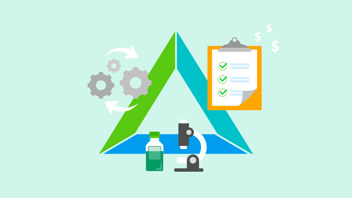Complicating the experiment planning process slows down your lab staff’s ability to analyze data and deliver results. Archaic tools and equipment, delays from lab supply shipments, and inaccuracies in manual-record keeping all have the potential to halt the planning process, making future research and development increasingly difficult.
In the lab of the future, simplified methods and technology offering automation and accuracy are key to making the work and life of your lab staff that much easier. By streamlining the experiment planning and management process, labs have more time to focus on the experiment, and can decrease time to milestone. A side benefit is making research more reproducible and collaborative, supporting overall scientific innovation.
Researchers, lab managers, and leadership teams can set themselves up for success by learning the importance of using tech in experiment planning and the best strategies and tools to do so.
Why Use Tech for Experiment Planning
For biotech businesses early in their lifecycle, time and resources are of the essence. Planning experiments in advance, and using the right tech and equipment when doing so, creates efficient lab environments that run like well-oiled machines. Agile experiment planning also allows leadership teams to refocus their attention on company priorities, and value-rich resources like drug chemistry, and disease comprehension.
As you scale, planning becomes even more paramount, as lab teams grow larger in size, capital increases, experiments become more complex, and access to resources expands. Ginkgo Bioworks raised more than $900 million from investors, but it started as a team of five, founded on the ideals of transforming traditional biology into reusable code and sophisticated computing.
Using a broad range of technologies, including cloud-based collaborative software, electronic notebooks, and artificial intelligence keeps researchers informed about experiment planning stages and progress. It also helps biotech enterprises to streamline product and drug development.
4 Tech Tips for Smart Experiment Planning
As new technologies are developed and equipment is made widely available, new methods for experiment planning will emerge. Part of experiment planning also involves ensuring the technology and equipment researchers use is up to speed with the demands of your lab. Don’t lose out on valuable research and drug development opportunities because your methods for planning are stuck in 1983.
Below are four options to get you started with your own experiment planning in the lab of the future.
1. Use Electronic Notebooks
Notebooks are vital for accurate record-keeping, maintaining experiment results, noting material storage, as well as sharing discoveries with colleagues. However, one of the biggest challenges with traditional lab notebooks is keeping track of data spread out across various sources, and written by various authors.
An electronic notebook offers enhanced functionality, changing the way research is recorded and performed. In the beginning stages of experimentation, maintaining proper documentation allows for lab staff and researchers to easily repeat experiments. Electronic notebooks gather data, where disconnected spreadsheets and documents exist in silos.
Electronic notebooks also provide catalogs of where materials are located and how they’re stored, which is critical to lab efficiency. The difference between maintaining samples, and having to throw away compromised resources might be only a few degrees. Knowing which freezer, fridge, or cabinet your materials are stored in, as well as maintaining detailed records of temperatures within these spaces ensures sample integrity remains intact.
2. Implement Artificial Intelligence + Machine Learning for Experiment Monitoring
As experiment data becomes increasingly complex, not only within the planning stage but the analysis stage, artificial intelligence (AI) helps by automating, analyzing, and integrating vast amounts of information. AI also allows researchers to re-evaluate the design and planning of their experiments, while saving valuable time in the lab.
Unlike manual research capabilities, AI is able to operate at any time, and is not restricted by lab staff hours. In addition, machine learning is constantly adapting and learning about incoming data in order to make better decisions. For example, robotic applications working in tandem with AI are able to determine ideal reagent combinations for producing optimal reactions.
3. Start Small when Using Analytics Platforms and Equipment
For startup biotech labs, initial analytics platforms may have less capabilities than those of a $100 million dollar pharmaceutical firm. Global pharmaceutical sales and marketing firm Eularis, developed E-VAI, a decision-making AI platform. Using machine learning algorithms, it produces analytical roadmaps, helping to identify future drivers for pharmaceutical sales.
Additionally, when first starting out, experimental planning might take place using ad hoc equipment and scraped together materials. With the example of Ginkgo Bioworks, the company purchased equipment well below market value when first starting out. Presently, their current automation labs cost over $500 million to maintain.
Eularis and Ginkgo Bioworks demonstrate potential growth that comes from planning and starting small. Their scaled-up technologies help biotech and pharmaceutical companies analyze existing data surrounding research and development.
4. Use a Life Sciences Marketplace for Reagents and Supplies
Keeping tabs on incoming lab orders and supplies is just as important as detailing experimental discoveries. When valuable reagents for chemical analysis are out of stock, experimentation stages become dead in the water, and researchers fall behind on project timelines.
Part of agile experiment planning is selecting a life sciences marketplace that allows for efficient product research, timely shipping updates, and access to experts who can recommend appropriate product alternatives. It should also offer lab managers efficient tracking capabilities of delayed shipments, out of stock items, and scheduling updates.
Life science marketplaces, like ZAGENO, offer diversified lab supplier options from thousands of vendors, ensuring multiple sources to source supplies from. Even if one supplier is delayed, lab staff can proceed with other experimental components, knowing their remaining supplies are enroute.
Diversifying your current tech and equipment with new tools and methods will help your lab team streamline experiment processes, ultimately leading to more efficient lab processes overall. Knowing how, and when to invest in setting up or revamping your tech stack will create long-term success for lab teams.
Learn more about simplifying the procurement process for biotech companies and take an extra step towards turning your lab into the lab of the future.




